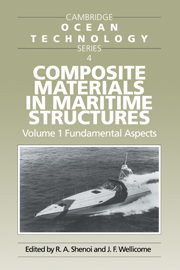Book contents
- Frontmatter
- Contents
- Preface
- List of Authors
- 1 A Strategic Overview
- 2 Background to Materials Science
- 3 Environmental Aspects
- 4 Production by Resin Transfer Moulding
- 5 An Engineering Approach to the Prediction of Elastic Properties of a Laminate
- 6 Mechanics of Orthotropic Laminae
- 7 Analysis of Laminated Composites
- 8 Theory of Sandwich Beams and Plates
- 9 Design of Anisotropic Panels
- 10 Finite Element Analysis of Composites
- 11 Theoretical Predictions of Failure Mechanisms and Strength
- 12 Considerations of Failure Theories in Design
- 13 The Procedures and Standards
- Appendix
- Index
10 - Finite Element Analysis of Composites
Published online by Cambridge University Press: 04 August 2010
- Frontmatter
- Contents
- Preface
- List of Authors
- 1 A Strategic Overview
- 2 Background to Materials Science
- 3 Environmental Aspects
- 4 Production by Resin Transfer Moulding
- 5 An Engineering Approach to the Prediction of Elastic Properties of a Laminate
- 6 Mechanics of Orthotropic Laminae
- 7 Analysis of Laminated Composites
- 8 Theory of Sandwich Beams and Plates
- 9 Design of Anisotropic Panels
- 10 Finite Element Analysis of Composites
- 11 Theoretical Predictions of Failure Mechanisms and Strength
- 12 Considerations of Failure Theories in Design
- 13 The Procedures and Standards
- Appendix
- Index
Summary
INTRODUCTION
During the last two decades, the finite element (FE) method of analysis has rapidly become a very common technique for the solution of complex problems in engineering by computer codes. One of the oldest fields of application of the FE method, and the most interesting in this instance is the structural one.
The objective of this Chapter is to provide a broad overview of the FE techniques, in general for structural application, and in particular to illustrate the possibility of applying them to composite materials. As a first step, it is necessary to provide a brief resume of the physical and mathematical bases which represent the fundamental background for the FE method.
The second step aims to give an understanding of the basic features of the method itself and an idea of the typical elements. Thirdly, the introduction of higher order/complex elements is the best way to explain the extension of this technique to layered shells and thus to composite materials.
In this context, and in particular as concerns the theoretical aspects, in order to simplify the treatment, we will refer to mechanical loads and to static analysis, but in principle all the concepts can be extended to thermal loads and dynamic analysis.
BACKGROUND TO FE TECHNIQUES
Fundamentals of Elasticity
For the determination of the distribution of displacement and stress in a structure under external loading, it is necessary to obtain a solution to the basic equations of the theory of elasticity and satisfy the imposed boundary conditions on forces and/or displacements. For a general three-dimensional structure, these equations are:
six strain-displacement equations
six stress-strain equations
three equations of equilibrium
- Type
- Chapter
- Information
- Composite Materials in Maritime Structures , pp. 255 - 279Publisher: Cambridge University PressPrint publication year: 1993



